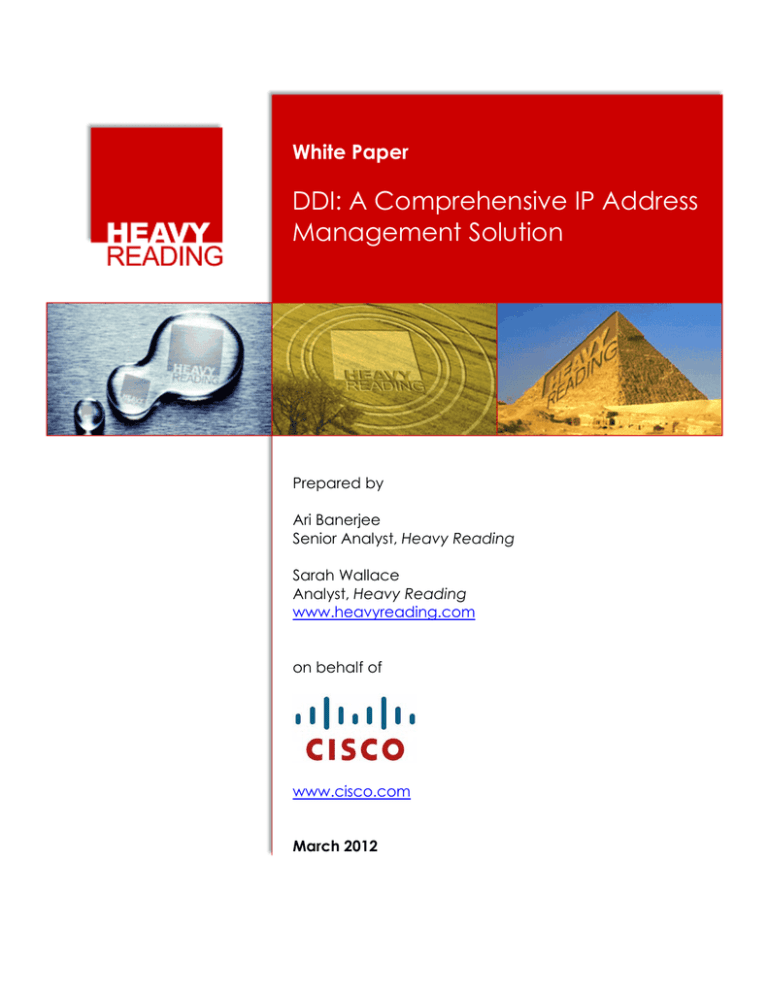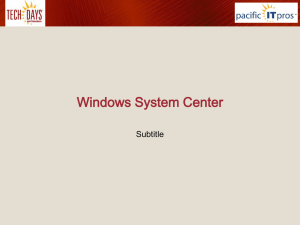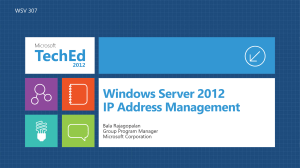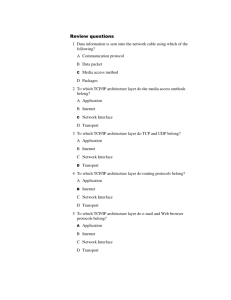DDI: A Comprehensive IP Address Management Solution White Paper
advertisement

White Paper DDI: A Comprehensive IP Address Management Solution Prepared by Ari Banerjee Senior Analyst, Heavy Reading Sarah Wallace Analyst, Heavy Reading www.heavyreading.com on behalf of www.cisco.com March 2012 Introduction With data growth exploding and the anticipation of trillions of IP addresses being available due to IPv6, it is more crucial than ever that service providers have an IP Address Management (IPAM) process in place. Many IT organizations have been manually managing IP addresses with spreadsheets – a labor-intensive process that is error-prone and time-consuming. A full-featured or comprehensive IPAM solution can simplify IP network management by automating and centralizing the management of IPv4 and IPv6 addresses with DNS and DHCP server configurations, while at the same time making the network more efficient and ultimately reducing costs. On the back end, as the world transitions from IPv4 to IPv6 and networks become inundated with more IP traffic, providers can use IPAM to make sure that the transition from IPv4 to IPv6 is seamless to the end user. As the world transitions from IPv4 to IPv6, which is expected to take 8 to 12 years, service providers want to work with a vendor that minimizes complexities and costs while they transition from IPv4 to a dual-stack IPv4/v6 environment (see Figure 1). Figure 1: Consolidated IP Address Management Source: Cisco A comprehensive IPAM solution will help service providers plan and manage IP traffic more efficiently and in real time. The most comprehensive IPAM solution will not only help service providers improve IPAM, but also the business operations that are linked to it (such as ERP and CRM) by ensuring their quality of service and availability at all times. This solution will ideally have integrated DNS and DHCP with IPAM functionality. HEAVY READING | MARCH 2012 | WHITE PAPER | DDI: A COMPREHENSIVE IP ADDRESS MANAGEMENT SOLUTION 2 The Transition to IPv6 The standard of Internet Protocol (IP) is significant in that it has affected all Internet traffic. IP addressing has been compared to the number scheme of phone numbers, in that it: · Uses a numbering system to route traffic · The numbering system has reached the point of exhaustion IP addresses route data packets to networked devices using a numbering scheme based on a 32-bit binary code. The binary code number sequence for the current IP addressing protocol (IPv4) has a number variation capacity of 4 billion. With the number of networked devices growing exponentially on a daily basis, 4 billion is a small number. And, according to the Internet Society (ISOC), the Internet is currently out of addresses and each of the five regions of the world (North America, Asia/Pacific, Europe/Middle East, Africa and Latin America) have all received their final blocks of addresses. ISOC predicts these five regions will each run out of IPv4 addresses at different times, hence the need to transition to IPv6. IPv6 is a result of the Internet Engineering Task Force (IETF) totally skipping over 64bit addressing and instead settling on a 128-bit addressing scheme. This means that the number of variations or addresses available through IPv6 is 340 trillion, trillion, trillion – or in other words, 340 undecillion. In addition to the obvious point of more IP addresses, IPv6 also brings the promise of improved security, as the IETF has ruled that all IPv6 standards-compliant implementations must use Internet Protocol Security (IPsec), which encrypts and authenticates packets of data traveling on a network. IPsec is different from more traditional security standards such as SSL because it is application- and platformagnostic. With the transition to IPv6, it seems the world is ready for a limitless number of IP addresses. And with devices such as smartphones and tablets experiencing a boom, and consumers and service providers anticipating growth in machine-tomachine (M2M), the handing of these limitless IP addresses will be critical for a service provider trying to provide a seamless end-to-end customer experience without interruption of service or content. This is where IPAM will be vital. HEAVY READING | MARCH 2012 | WHITE PAPER | DDI: A COMPREHENSIVE IP ADDRESS MANAGEMENT SOLUTION 3 IP Address Management As already mentioned, IP addresses are an integral part of any network, and they have been so consumed that apparently 4 billion was not enough. And, with more applications and devices emerging every day and the transition to IPv6, the number of IP addresses being handled will only be growing, and at a rapid pace. This is why IPAM will be so important. Every networked application and device (such as file storage, printers, gaming consoles and mobile devices and applications) depends on IP and requires address assignment. Handing this IP traffic is becoming increasingly difficult as new services such as VoIP and mobile networks increase IP address assignment needs. This is in addition to the transition to IPv6. All the previously mentioned factors mean that networks should have a robust IPAM solution that allocates, classifies and tracks addresses. A full-featured and integratable IPAM solution helps network administrators eliminate network conflicts and outages, track critical assets, ensure network security and providing reports based on a wide range of parameters, including IP address status (dynamic, static, available, reserved, etc.), hostnames, MAC address and more. IPAM also allows for: · Address Planning – planning out an IP network in which blocks of IP addresses are treated as subnets and supernets · Discovery – discovering and documenting of IP space · Configuration – configuring and managing IP name and address space · Monitoring and Reporting – accurate reporting of IP address usage; of paramount importance to maintaining an auditable, secure and outagefree network · Workflow and Delegation – workflow and role-based administration HEAVY READING | MARCH 2012 | WHITE PAPER | DDI: A COMPREHENSIVE IP ADDRESS MANAGEMENT SOLUTION 4 The Role of IP Address Management IPAM is important because it is crucial for a network administrator to have realtime access to IPAM data. For example, a network administrator can immediately access IP addresses in use to identify potential network abuse or security breaches by internal or foreign users. As network access control (NAC) systems become more widely deployed, IPAM will play a key role in facilitating and monitoring the enforcement of policies. Such policies would include validating that the operating system and anti-virus software is current before assigning an IP address and granting access to the network. There are different approaches to implementing IPAM. One is the manual documentation of IP address using home-grown spreadsheets. However, the length and complexity of IPv6 addresses – these are 128-bit numbers that are conventionally expressed using hexadecimal strings (e.g., 2001:0db8:582:ae33::29) – creates more opportunity for manual errors. For most service providers and enterprises that are looking to IP-based services and devices, this is not realistic. In contrast, there are larger-scale, comprehensive software-based IPAM solutions that are implemented by service providers. These solutions typically comprise a dedicated IPAM application and dedicated database at a central site, as well as DNS and DHCP servers at remote sites. Server configurations and address management reports are generated at the central site, while the remote servers communicate with the central site to exchange configuration and DNS and DHCP data. These larger-scale comprehensive IPAM solutions offer a range of benefits such as functionality and customization capabilities, and they can be integrated with other key enterprise applications, such as ERP and CRM, which helps to integrate the IP information across all lines of business. They are also highly scalable. HEAVY READING | MARCH 2012 | WHITE PAPER | DDI: A COMPREHENSIVE IP ADDRESS MANAGEMENT SOLUTION 5 DNS, DHCP & IP Address Management Having automated, centralized IPAM is crucial in helping service providers manage the copious amounts of IP traffic that will come as the world transitions from IPv4 to IPv6 and network traffic grows. In this discussion of IPAM, there has been mention of DNS and DHCP, but how are DNS and DHCP important to IPAM? The domain name system (DNS) is the way in which Internet domain names are located and translated into IP addresses. Since maintaining a central list of domain name/IP address correspondences would be impractical, the lists of domain names and IP addresses are distributed throughout the Internet in a hierarchy of authority, and hence a DNS server that maps the domain names in your Internet requests or forwards them to other servers in the Internet is imperative to prioritizing and routing IP traffic. However, DNS records can become corrupt, contain incorrect information, or sometimes even disappear. These types of errors increase security and compliance risks, and having a comprehensive IPAM solution that allows full view and careful management of DNS operations is crucial. Dynamic Host Configuration Protocol (DHCP) is a protocol that allows network administrators to centrally manage and automate the assignment of IP addresses to devices in a network. This prevents end users and desktop administrators from having to manually assign IP addresses to devices and enhances the administrator's overall effectiveness. However, the main benefit of using DHCP (in terms of the IPv4 to IPv6 transition) is that it allows a finite amount of IP address space to be partitioned out to transient users as needed (leased for a certain amount of time) and for addresses no longer in use to be reclaimed. In essence, the network is basically leasing IP addresses, rather than assigning static addresses. This renting of IP addresses is usually sessionbased and lasts the amount of time the end user is on the Internet. The process itself helps to allocate and reduce the number of IP addresses being handled. DHCP also enables machines (such as servers, game consoles, etc.) to be online and request IP information from a DHCP server automatically. Most home users have this set up as part of their home network with a home router (wired or wireless) as the DHCP server that manages IP information, allocates it to those machines requesting Internet access (desktop, laptop, iPad, etc.), and tracks that IP information in a small DHCP table. The efficiency of the DHCP protocol allows service providers to greatly speed up their network and enables end users to easily access the network. The notion of what the IP address is being used for is not relevant to most ISPs, as they are only concerned with bandwidth constraints. And, because of its efficiency in processes and resources, DHCP also reduces costs for service providers – hence its important role in a comprehensive IPAM strategy. HEAVY READING | MARCH 2012 | WHITE PAPER | DDI: A COMPREHENSIVE IP ADDRESS MANAGEMENT SOLUTION 6 Vendor Profile As the world transitions to IPv6 and there will no longer be such constraints on the number of IP addresses, service providers will want to work with a vendor that provides comprehensive IP management that is both compatible with both IPv4 and IPv6 environments while managing these environments in a seamless manner. Cisco Prime Network Registrar is a scalable, high-performance, extensible solution that provides integrated DNS, DHCP, and IPAM services – collectively, DDI. For cable providers, Cisco Prime Network Registrar provides reliable, scalable DNS and DHCP services for millions of devices and forms the basis of a Docsis cable modem provisioning system. Additionally, Cisco Prime Network Registrar plays an important role in service activation for data, voice-over-IP (VoIP), and mobile services. Figure 2: Cisco DHCP Avalanche Protection Source: Cisco Network operators require DNS and DHCP systems that support both IPv4 and IPv6 as well as a full-featured, automated IPAM solution to plan, track, and manage IP addresses and ease the transition to IPv6. Cisco Prime Network Registrar supports the IPv4 to IPv6 transition and allows dualstack deployments on a single server. The solution includes the following integrated components and their respective services – all supporting both IPv4 and IPv6: HEAVY READING | MARCH 2012 | WHITE PAPER | DDI: A COMPREHENSIVE IP ADDRESS MANAGEMENT SOLUTION 7 · A single DHCP server for device network access · A single DNS server for IP address translation and service delivery · A DNS caching server that supports DNS Security Extensions (DNSSEC) for added DNS security that is designed to prevent cache poisoning and other attacks · A powerful, comprehensive IPAM system to automate and manage all IP address requirements Cisco Prime Network Registrar is a DDI solution that has the following traits: · Proven scalability with DHCP services for more than 50 million devices in a single customer deployment · Reliability: DHCP safe-failover, support for high-availability DNS, IPAM database replication for backup of IPAM data, and unsurpassed avalanche prevention to reduce downtime after network outages (see Figure 2) · Centralized, automated management of IPv4 and IPv6 address space · Fast: Able to assign more than 47,000 DHCP leases per second and significantly accelerate DNS queries HEAVY READING | MARCH 2012 | WHITE PAPER | DDI: A COMPREHENSIVE IP ADDRESS MANAGEMENT SOLUTION 8 Conclusion In addition to increased data traffic through applications and devices, there is also the anticipation and transition from IPv4 to IPv6, which is making IPAM a high priority for service providers. There has definitely been a big push by ISOC and companies such as AT&T, Verizon, Comcast, Sprint, Skype, Facebook and vendors such as Cisco, which are showing support through collaboration and testing networks for both preparedness and possible issues and limitations of IPv6. These companies – among many others – believe it is crucial that service providers, equipment vendors, OS developers and website operators work together so that consumers experience a seamless IP experience on the front end. But in truth, most consumers are not aware of the IPv4 to IPv6 transition, and parties from all sides are hoping consumers will be none the wiser. As we move further away from IPv4 and into IPv6, and mindsets are those of a world of infinite IP addresses; companies large and small need to consider IPAM as a requirement for a modern network, especially as new applications and devices are increasing IP address demands. Service providers need to have a robust IPAM solution in place that has integrated DNS and DHCP with IPAM functionality. Thus, a comprehensive IPAM solution will allow the management of IP traffic to be more efficient and real-time, as well as have a positive effect on other areas such as the business layer and contribute positively to overall customer experience management. HEAVY READING | MARCH 2012 | WHITE PAPER | DDI: A COMPREHENSIVE IP ADDRESS MANAGEMENT SOLUTION 9



